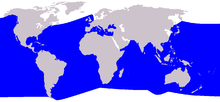
Back حوت كوفييه ذو المنقار Arabic حوت كوفييه ذو المنقار ARZ Yabol (Ziphius cavirostris) AVK Клюномуцунест кит на Кювие Bulgarian Zifio Cuvier Breton Zífid comú Catalan Ziphius cavirostris CEB Vorvaňovec zobatý Czech Morfil Gylfinog Cuvier Welsh Småhovedet hval Danish
| Cuvier's beaked whale | |
|---|---|

| |

| |
| Size compared to an average human | |
| Scientific classification | |
| Domain: | Eukaryota |
| Kingdom: | Animalia |
| Phylum: | Chordata |
| Class: | Mammalia |
| Order: | Artiodactyla |
| Infraorder: | Cetacea |
| Family: | Ziphiidae |
| Genus: | Ziphius Cuvier, 1823 [4] |
| Species: | Z. cavirostris
|
| Binomial name | |
| Ziphius cavirostris | |

| |
| Range of Cuvier's beaked whale | |
| Synonyms[5][6] | |
|
Genus synonymy
Species synonymy
| |
The Cuvier's beaked whale, goose-beaked whale, or ziphius (Ziphius cavirostris) is the most widely distributed of all beaked whales in the family Ziphiidae.[7] It is smaller in size than most baleen whales—and indeed the larger toothed cetaceans (like orca and sperm whales)—yet it is large among the beaked whales and smaller cetaceans, appearing somewhat like a bigger and stockier bottlenose dolphin. Cuvier's beaked whale is pelagic, generally inhabiting waters deeper than 300 m (1,000 ft), though it has been observed closer to shore on occasion. In these offshore waters, Cuvier's beaked whale executes some of the deepest, longest recorded dives among whales, and extant mammals, at 2,992 m (9,816 ft), for 222 minutes. While likely diving to forage and hunt prey, such as cephalopods, and potentially evade predators (like the aforementioned orca), the frequency and exact reason for these extraordinary dives is unclear.[8][9] Despite its deepwater habitat, it is one of the most frequently-spotted beaked whales when surfacing.[3]
Cuvier's beaked whale was named Ziphius cavirostris by Georges Cuvier based on a skull fragment which he believed to be a fossil from an extinct species.[10] He reused the genus name Ziphius from an undetermined species mentioned by historical sources.[11] The species name, cavirostris, comes from the Latin cavus ("hollow") and rostrum ("beak"), and refers to the bony cavity of the nares (nasal bones), now known as the prenarial basin. This feature is now known to be unique to male Z. cavirostrus.[12][10]
- ^ "Ziphius cavirostris Cuvier 1824 (Cuvier's beaked whale)". PBDB.
- ^ Baird, R.W.; Brownell Jr.; R.L.; Taylor, B.L. (2020). "Ziphius cavirostris". IUCN Red List of Threatened Species. 2020: e.T23211A50379111. doi:10.2305/IUCN.UK.2020-3.RLTS.T23211A50379111.en. Retrieved 12 November 2021.
- ^ a b "Cuvier's Beaked Whale (Ziphius cavirostris)". NOAA Fisheries. December 29, 2021.
- ^ a b Perrin WF, ed. (2014). "Ziphius Cuvier, 1823". World Cetacea Database. World Register of Marine Species. Retrieved 16 March 2015.
- ^ "Ziphius". Global Biodiversity Information Facility. Retrieved 11 April 2021.
- ^ "Ziphius cavirostris". Global Biodiversity Information Facility. Retrieved 11 April 2021.
- ^ Grzimek, Bernhard (2003). Hutchins, Michael; Kleiman, Devra G.; Geist, Valerius; et al. (eds.). Grzimek's Animal Life Encyclopedia, Vol 15, Mammals IV (2nd ed.). Farmington Hills, MI: Gale Group. ISBN 0-7876-5362-4.
- ^ Schorr, Gregory S.; Falcone, Erin A.; Moretti, David J.; Andrews, Russel D. (26 March 2014). "First Long-Term Behavioral Records from Cuvier's Beaked Whales (Ziphius cavirostris) Reveal Record-Breaking Dives". PLOS ONE. 9 (3): e92633. Bibcode:2014PLoSO...992633S. doi:10.1371/journal.pone.0092633. PMC 3966784. PMID 24670984.
- ^ Quick, Nicola J.; Cioffi, William R.; Shearer, Jeanne M.; Fahlman, Andreas; Read, Andrew J. (15 September 2020). "Extreme diving in mammals: first estimates of behavioural aerobic dive limits in Cuvier's beaked whales". The Journal of Experimental Biology. 223 (18): jeb222109. doi:10.1242/jeb.222109. PMID 32967976. S2CID 221886321.
- ^ a b Allen, B. M.; Brownell, R. L.; Mead, J. G. (2011). "Species review of Cuvier's beaked whale, Ziphius cavirostris (report SC/63/SM17)" (PDF). Scientific Committee Documents. International Whaling Commission. Retrieved 8 June 2022.
- ^ Cuvier, Georges (1823). Recherches sur les ossemens fossiles (in French). Vol. 5 (2nd ed.). Paris. pp. 350–2, fig. 7. Retrieved 3 February 2013.
- ^ Omura, Hideo (1972). "An osteological study of the Cuvier's beaked whale, Ziphius cavirostris, in the northwest Pacific" (PDF). The Scientific Reports of the Whales Research Institute. 24: 1–34.
